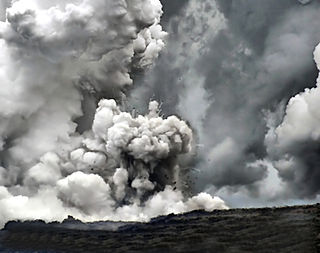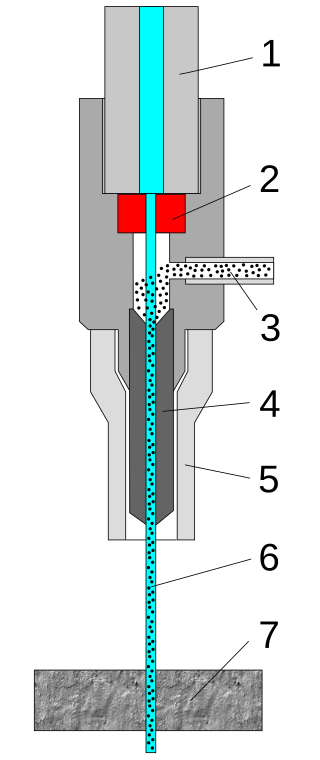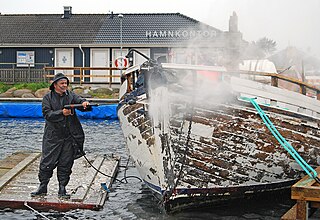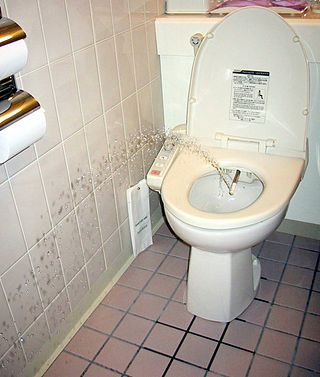
A jetboat is a boat propelled by a jet of water ejected from the back of the craft. Unlike a powerboat or motorboat that uses an external propeller in the water below or behind the boat, a jetboat draws the water from under the boat through an intake and into a pump-jet inside the boat, before expelling it through a nozzle at the stern.

Sewerage is the infrastructure that conveys sewage or surface runoff using sewers. It encompasses components such as receiving drains, manholes, pumping stations, storm overflows, and screening chambers of the combined sewer or sanitary sewer. Sewerage ends at the entry to a sewage treatment plant or at the point of discharge into the environment. It is the system of pipes, chambers, manholes, etc. that conveys the sewage or storm water.

A nozzle is a device designed to control the direction or characteristics of a fluid flow as it exits an enclosed chamber or pipe.

A bidet is a bowl or receptacle designed to be sat upon in order to wash one's genitalia, perineum, inner buttocks, and anus. The modern variety has a plumbed-in water supply and a drainage opening, and is thus a plumbing fixture subject to local hygiene regulations. The bidet is designed to promote personal hygiene and is used after defecation, and before and after sexual intercourse. It can also be used to wash feet, with or without filling it up with water. In several European countries, a bidet is now required by law to be present in every bathroom containing a toilet bowl. It was originally located in the bedroom, near the chamber-pot and the marital bed, but in modern times is located near the toilet bowl in the bathroom. Fixtures that combine a toilet seat with a washing facility include the electronic bidet.

A water cannon is a device that shoots a high-velocity stream of water. Typically, a water cannon can deliver a large volume of water, often over dozens of meters. They are used in firefighting, large vehicle washing, riot control, and mining. Most water cannons fall under the category of a fire monitor.

A shower is a place in which a person bathes under a spray of typically warm or hot water. Indoors, there is a drain in the floor. Most showers have temperature, spray pressure and adjustable showerhead nozzle. The simplest showers have a swivelling nozzle aiming down on the user, while more complex showers have a showerhead connected to a hose that has a mounting bracket. This allows the showerer to hold the showerhead by hand to spray the water onto different parts of their body. A shower can be installed in a small shower stall or bathtub with a plastic shower curtain or door. Showering is common due to the efficiency of using it compared with a bathtub. Its use in hygiene is, therefore, common practice.
A vacuum ejector, or simply ejector is a type of vacuum pump, which produces vacuum by means of the Venturi effect.

A splash pad or spray pool is a recreation area, often in a public park, for water play that has little or no standing water. This is said to eliminate the need for lifeguards or other supervision, as there is little risk of drowning.

A steam explosion is an explosion caused by violent boiling or flashing of water or ice into steam, occurring when water or ice is either superheated, rapidly heated by fine hot debris produced within it, or heated by the interaction of molten metals. Pressure vessels, such as pressurized water (nuclear) reactors, that operate above atmospheric pressure can also provide the conditions for a steam explosion. The water changes from a solid or liquid to a gas with extreme speed, increasing dramatically in volume. A steam explosion sprays steam and boiling-hot water and the hot medium that heated it in all directions, creating a danger of scalding and burning.

Plasma arc welding (PAW) is an arc welding process similar to gas tungsten arc welding (GTAW). The electric arc is formed between an electrode and the workpiece. The key difference from GTAW is that in PAW, the electrode is positioned within the body of the torch, so the plasma arc is separated from the shielding gas envelope. The plasma is then forced through a fine-bore copper nozzle which constricts the arc and the plasma exits the orifice at high velocities and a temperature approaching 28,000 °C (50,000 °F) or higher.

The IP code or ingress protection code indicates how well a device is protected against water and dust. It is defined by the International Electrotechnical Commission (IEC) under the international standard IEC 60529 which classifies and provides a guideline to the degree of protection provided by mechanical casings and electrical enclosures against intrusion, dust, accidental contact, and water. It is published in the European Union by the European Committee for Electrotechnical Standardization (CENELEC) as EN 60529.

A water jet cutter, also known as a water jet or waterjet, is an industrial tool capable of cutting a wide variety of materials using an extremely high-pressure jet of water, or a mixture of water and an abrasive substance. The term abrasive jet refers specifically to the use of a mixture of water and an abrasive to cut hard materials such as metal, stone or glass, while the terms pure waterjet and water-only cutting refer to waterjet cutting without the use of added abrasives, often used for softer materials such as wood or rubber.

Pressure washing or power washing is the use of high-pressure water spray to remove loose paint, mold, grime, dust, mud, and dirt from surfaces and objects such as buildings, vehicles and concrete surfaces. The volume of a mechanical pressure washer is expressed in gallons or liters per minute, often designed into the pump and not variable. The pressure, expressed in pounds per square inch, pascals, or bar, is designed into the pump but can be varied by adjusting the unloader valve. Machines that produce pressures from 750 to 30,000 psi or more are available.

Thermal spraying techniques are coating processes in which melted materials are sprayed onto a surface. The "feedstock" is heated by electrical or chemical means.

A spray nozzle or atomizer is a device that facilitates the dispersion of a liquid by the formation of a spray. The production of a spray requires the fragmentation of liquid structures, such as liquid sheets or ligaments, into droplets, often by using kinetic energy to overcome the cost of creating additional surface area. A wide variety of spray nozzles exist, that make use of one or multiple liquid breakup mechanisms, which can be divided into three categories: liquid sheet breakup, jets and capillary waves. Spray nozzles are of great importance for many applications, where the spray nozzle is designed to have the right spray characteristics.

Boiler feedwater is an essential part of boiler operations. The feed water is put into the steam drum from a feed pump. In the steam drum the feed water is then turned into steam from the heat. After the steam is used, it is then dumped to the main condenser. From the condenser, it is then pumped to the deaerated feed tank. From this tank it then goes back to the steam drum to complete its cycle. The feedwater is never open to the atmosphere. This cycle is known as a closed system or Rankine cycle.

A hydraulophone is a tonal acoustic musical instrument played by direct physical contact with water where sound is generated or affected hydraulically. The hydraulophone was described and named by Steve Mann in 2005, and patented in 2011. Typically, sound is produced by the same hydraulic fluid in contact with the player's fingers. It has been used as a sensory exploration device for low-vision individuals.

A bidet shower—also known as a handheld bidet, commode shower, toilet shower, health faucet, bum shower, jet spray, Muslim shower, shatafa or bum gun—is a hand-held triggered nozzle that is placed near the toilet and delivers a spray of water used for anal cleansing and cleaning of the genitals after using the toilet for defecation and urination, popularised by Arab nations where the bidet shower is a common bathroom accessory. The device is similar to that of a kitchen sink sprayer.

An electronic bidet is a seat attached to an existing toilet or a part of the toilet itself, with a nozzle to squirt a jet of warm water for cleaning the anus and female genitals, electrically powered and with electronic controls. It replaces the conventional bidet, a separate plumbing fixture not attached to a toilet. Some bidets of this type have one adjustable nozzle on the side rim for anus and genital areas, or two nozzles on the back rim, a shorter "family nozzle" for washing the area around the anus, and a longer "bidet nozzle" for women to wash their vulva.


















